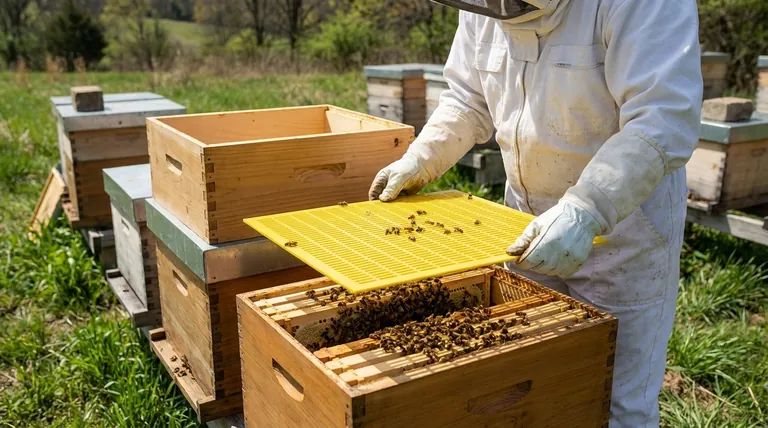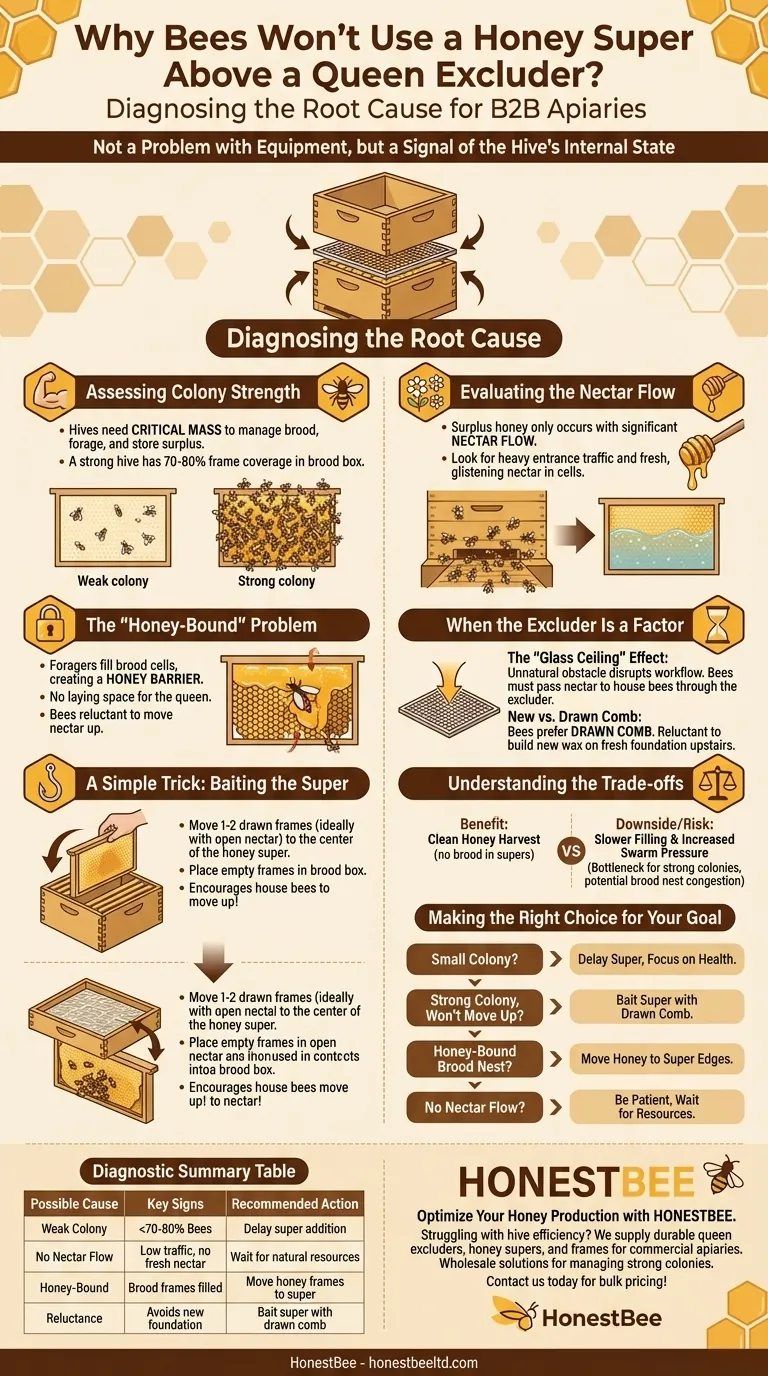In most cases, bees fail to use a honey super because the colony is not yet strong enough or there is no significant nectar flow. The bees are not ignoring the super out of spite; their behavior is a direct reflection of their population size and the resources available in the environment. The queen excluder itself is often blamed, but it is rarely the primary cause of this inactivity.
Your bees' refusal to move into a honey super is not a problem with the equipment, but a signal about the hive's internal state. Understanding whether the issue is colony strength, available space, or environmental conditions is the key to solving it.

Diagnosing the Root Cause
Before blaming the queen excluder, you must assess the two fundamental drivers of honey storage: the workforce and the raw materials.
Assessing Colony Strength
A hive needs a critical mass of bees to manage the brood nest, regulate temperature, forage, and have a surplus of workers to build comb and store honey upstairs.
If the brood boxes below the excluder are not overflowing with bees, the colony simply lacks the population to expand. A strong hive will have bees covering at least 70-80% of the frames in the top brood box.
Evaluating the Nectar Flow
Bees only store significant surplus honey when there is a "nectar flow"—a period when multiple floral sources are producing abundant nectar.
You can verify a flow by observing heavy flight traffic at the entrance and inspecting the frames. Look for cells filled with fresh, watery nectar that glistens in the sun. If you don't see this, the bees have no surplus to store.
The "Honey-Bound" Problem
Sometimes the colony is strong and a flow is on, but the bees still won't go up. This often happens when the brood nest becomes "honey-bound."
Foragers store nectar in the first available empty cells, which are often in the brood chamber. If these cells fill up, it creates a "honey barrier" that leaves the queen with no room to lay eggs, which can restrict colony growth and encourage swarming. The bees are often reluctant to move this nectar up through the excluder.
When the Excluder Is a Factor
While not usually the root cause, the excluder can act as a secondary barrier that complicates the bees' upward expansion.
The "Glass Ceiling" Effect
The queen excluder is an unnatural obstacle. Forager bees must pass their nectar to house bees, who then must carry it through the excluder to store it. This extra step can disrupt workflow, especially for a colony that is not yet booming.
New vs. Drawn Comb
Bees are far more likely to cross an excluder and begin work on drawn comb that has been used before. They are highly reluctant to cross the excluder just to build brand-new wax on fresh foundation, which requires an enormous amount of energy.
A Simple Trick: Baiting the Super
To break this impasse, you can "bait" the bees upward. Take one or two frames of drawn comb, ideally with some open nectar, from your brood box and place them in the center of the honey super.
Place the empty frames you removed from the super into the brood box to give the queen more laying space. This simple swap encourages house bees to move up and creates a scent trail for others to follow.
Understanding the Trade-offs
Using a queen excluder is a management choice with clear benefits and potential downsides. Understanding them is critical for effective beekeeping.
The Benefit: A Clean Honey Harvest
The entire purpose of an excluder is to keep the queen in the brood boxes. This ensures your honey supers contain only honey, free from eggs, larvae, and pupae, which makes for a much cleaner and easier harvest.
The Downside: Slower Super Filling
The excluder can act as a bottleneck, slowing down a very strong colony during a heavy nectar flow. Some commercial beekeepers forgo excluders to maximize production, but this requires more advanced hive management.
The Risk: Increased Swarm Pressure
By confining the queen, an excluder can artificially congest the brood nest. If the queen runs out of laying space because of a honey-bound condition, the colony's primary impulse is to swarm. Proper space management is essential when using an excluder.
Making the Right Choice for Your Goal
Your next step depends entirely on your diagnosis of the hive.
- If your primary focus is a small or developing colony: Do not add a super yet. Focus on hive health and allow the population to build until the brood boxes are packed with bees.
- If your primary focus is a strong colony that won't move up: Bait the super by moving a frame of drawn comb or open nectar from the brood box into the center of the honey super.
- If your primary focus is a honey-bound brood nest: Free up laying space for the queen by moving a full frame of honey from the brood box to the outside edge of the honey super.
- If your primary focus is a lack of nectar flow: Be patient. You cannot force bees to make honey when the resources aren't available in nature.
Solving problems in beekeeping comes from learning to interpret the bees' behavior as a clear signal of their needs.
Summary Table:
| Possible Cause | Key Signs | Recommended Action |
|---|---|---|
| Weak Colony Strength | Brood boxes <70-80% full of bees | Delay super addition; focus on population growth |
| No Nectar Flow | Low flight traffic, no fresh nectar in cells | Wait for natural resources; do not force honey production |
| Honey-Bound Brood Nest | Brood frames filled with honey, queen has no laying space | Move honey frames to super edges to free up brood space |
| Reluctance to Cross Excluder | Bees avoid new foundation in super | Bait super with drawn comb/nectar frames from brood box |
Optimize Your Honey Production with HONESTBEE
Struggling with hive efficiency or super utilization? HONESTBEE supplies durable, precision-engineered beekeeping equipment—including queen excluders, honey supers, and frames—to commercial apiaries and distributors. Our wholesale-focused solutions help you manage strong colonies, maximize nectar flow yields, and reduce swarm risks. Contact our expert team today to discuss bulk pricing and tailored equipment packages for your operation.
Visual Guide

Related Products
- Professional Plastic Queen Excluder for Modern Beekeeping
- Wooden Queen Bee Excluder for Beekeeping
- High Performance Plastic Queen Excluder for Beekeeping and Apiary Management
- Plastic Queen Bee Excluder for Bee Hive Wholesale
- Premium Wood Framed Metal Wire Queen Bee Excluder
People Also Ask
- Why are queen excluders recommended for Flow Hives? Prevent Brood Damage for a Clean Harvest
- How does a queen excluder work? Master Hive Management for Pure Honey Harvests
- What are the pros of using a queen excluder? Boost Hive Control & Honey Quality
- What is a Queen Excluder and how does it work? Achieve Purer Honey & Better Hive Control
- What is the purpose of a queen excluder when adding a super? Streamline Your Honey Harvest



















